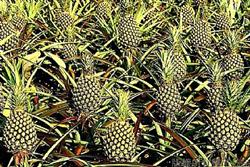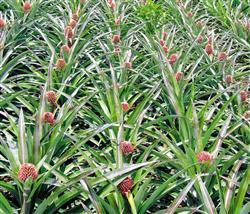Conditions for creating pineapple orchards

(1) Garden choice. Climatic conditions, soil conditions, transportation conditions and other influencing factors should be fully taken into account in the selection of pineapple orchards. 1. Climatic conditions. Suitable temperature, rainfall and sunshine are the basic conditions for the normal growth of pineapple. Pineapple has strong adaptability to climatic conditions and adaptability, but it is most suitable for warm and humid climate, avoiding frost, low temperature, overcast and rainy climate, generally requires annual average temperature 24-27 ℃, no frost and low temperature overcast and rain in winter, annual rainfall is 1000-2000mm, monthly rainfall distribution is uniform, annual sunshine hours are more than 1700h. Therefore, the construction of pineapple orchard, especially the large-scale development and management of pineapple production base, should try to choose areas with no frost in winter, low temperature, overcast and rain, and abundant water sources. 2. Soil condition. Pineapple can adapt to a wide range of soil, but it is most suitable for acid red soil with deep soil layer, good drainage, loose air permeability, high content of organic matter and good fertility. In particular, pineapple is more demanding on pH, pH in 4-5, that is, acidic, plant growth is normal, when pH is above 6, plant growth is blocked, this kind of soil is not suitable to grow pineapple. 3. Transportation conditions. As the harvest time of pineapple is relatively concentrated, the harvest peak is usually only about half a month, so the development of pineapple, especially for commercial production and development, must have more convenient transportation, so that fresh fruits and bulk raw materials for processing can be transported in time. (2) soil improvement. The root system of pineapple is shallow and aerobic. Most of the root groups extend horizontally with the soil layer and are distributed in the 20cm tillage layer. In the case of wasteland, soil consolidation and shallow tillage layer, soil improvement must be carried out, soil improvement should be emphasized, and then sufficient organic fertilizer should be applied to create a soil environment conducive to the growth of pineapple roots. (3) Garden planning. To carry out pineapple orchard planning, we should first use surveying instruments to draw 1/1000 or 1/10000 terrain sketches, scan the map, and investigate and collect local natural conditions, and then carry out garden planning on this basis. 1. The design of planting area. When designing the planting area, the scientific design should be carried out according to the size of the leased land and the degree of mechanization. Because the pineapple can be harvested only 1-2 years after planting, and the fruit trees with high yield one or two or three times after planting can achieve high yield and high efficiency under the condition of high level of cultivation and management. therefore, the design of the planting area should be advanced and scientific, and the planting area should be expanded as far as possible without affecting the operation. In order to make full use of land per unit area. 2. The setting of windbreak. The effect of windbreak forest on pineapple is as follows: first, to prevent wind; second, to reduce wind speed and evaporation; third, to reduce frost and cold damage. For orchards with large development area and gentle and open slope, the area of protective forest generally accounts for 10% of the planting area; for orchards with high wind speed or orchards affected by typhoons, shelterbelts can exceed 15%. Small-scale pineapples plant prickly shrubs around the garden, which can protect the garden against cattle, people and wind. 3. The design of the garden road network. The garden road consists of a trunk road, a slip road and an inter-park service road. The width of the road varies with the size of the orchard. For the large and medium-sized orchards developed in succession, the road width of the main road is 7m, the width of the branch road is 5m, and the working pavement of the planting area is 3m wide; the small orchard can be provided with a road 5m wide and a working access road 3m wide; the orchard with a width of 3m can be connected to the orchard with a width of 3m. 4. The design of water conservancy facilities in the garden. The water used in pineapple orchard is seasonal, and the pineapple producing area is usually irrigated during autumn drought. Therefore, the scale of water conservancy facilities should be small, mainly water storage and irrigation. For hilly orchards without water and water conservancy facilities, cisterns can be built in hills or at the top of the hills for irrigation and fertilization. Small reservoir can also be built per 667m2, can store water 20m2, professional households according to their own development of the area setting. According to each 100hm2 planting area, a large mechanized production plant can set up a water lifting station or a small water tower with a height of 5m for fertilization and spraying irrigation. While planning water conservancy facilities, drainage facilities should also be considered. China's pineapple producing areas are located in the south subtropics, Rain Water is more concentrated, drainage is particularly important; terraces and contour beds built in hills or low mountains must open drainage ditches on one side of the inner wall.
- Prev

Occurrence and Control of Stem Rot and Fruit Rot of Pineapple
Babylonian snail, also known as French snail, is a harmful animal to pineapple. It mainly bites the base of the fruit from June to August when the fruit is ripe, leaving holes of different depths, which makes the pineapple susceptible to infection and rot, thus reducing the commodity value of the fruit, even inedible. Control methods: (1) Artificial capture. In the east snail...
- Next

Key points of fertilization Management in Pineapple Orchard
Mineral nutrition in soil is the material basis of pineapple plant vegetative growth and reproductive growth. Soil fertility, fertilization amount, fertilizer quality and fertilization technology are one of the important factors that directly affect the normal growth and high yield and stability of pineapple plants. Pineapple is a kind of perennial herbaceous fruit tree with a harvest of 2-3.
Related
- Moge, come on! The staff of the peasant association in the producing area of cantaloupe were frightened when the crowd gathered.
- Causes and Solutions of low Fruit setting rate of Apple
- Symptoms and control measures of passion fruit virus disease
- Fruit growing lesson: how do apple orchards keep high yields?
- Can you build orchards in the mountains? What are the pros and cons?
- How to manage the coloring period of Crisson grape?
- This paper introduces the processing technology of two kinds of fig products.
- How much is a month for retired teachers in rural areas by 2020?
- How can strawberry planting increase sugar content? We should pay attention to management in many aspects.
- What are the cultivation techniques on how to improve the yield of golden fruit?

